When I first went to work at Arches National Park, my boss, Chief Ranger Jerry Epperson took me for an orientation drive/hike to familiarize me with the landscape and with some of its geology and history. We started early and spent the entire day in the field and on the road. We hiked out all the trails and even drove out the Salt Valley road to the Klondike Bluffs. By then it was running late and there was still so much more country to see, even as an overview. Jerry said, “We’ll hike out to Tower Arch in a couple days and I’ll show you the Ringhoffer inscription. And I’ll show you Eagle Park. It’s one of the few areas that was added to Arches when we transitioned from a monument to a park “
(When Congress passed legislation to make Arches a national park in 1971, the monument actually shrank by several thousand acres…politics.)
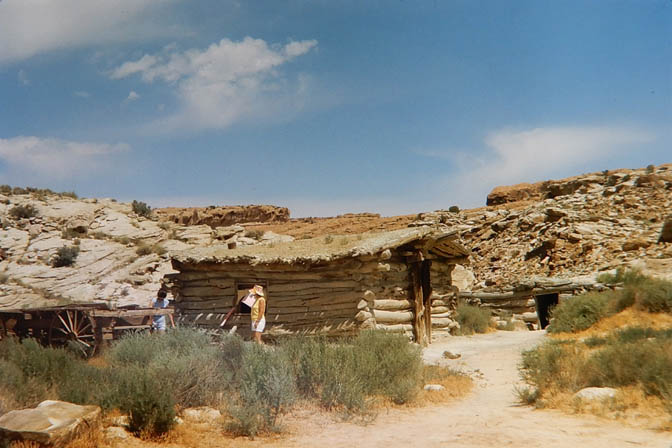
In 1976, the US Geologic Survey had not yet created a map exclusively for Arches. Instead it was possible to see a topographic rendering of the park by piecing together parts of several 15 minute USGS maps. Jerry had taken the time to cut those maps up and tape them together to create one large map of Arches. The maps of the area had not been updated in years and something caught my eye. As we turned down the road to Wolfe Ranch, I checked the map and noticed a different name. I pointed it out to Jerry.
He nodded. “Yeah for years, going all the way back to the monument’s creation, we all knew it as Turnbow Cabin.” He explained that Marv Turnbow was a local rancher who ran cattle out there for years, and had, in fact, been the Monument’s first custodian. But the companion story to Turnbow’s was John Wesley Wolfe. The park knew little of Wolfe and for years, the Arches staff believed that Wolfe had built the cabin in 1888 and resided there for over two decades. It even used that date in its literature.
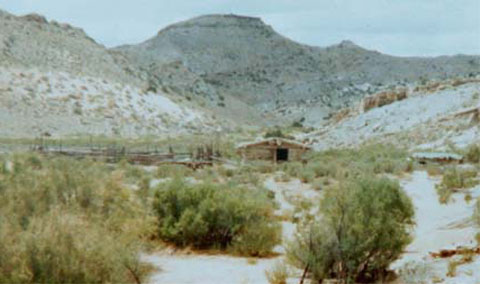
Then, around 1971, Esther Rison, the granddaughter of John Wesley Wolfe came to Arches to visit. It was her first return to the area since 1908. She provided a wealth of information to the park about her family, her grandfather, and her mother and father, who traveled to Utah to visit Wolfe in 1907. It was the only first hand account anyone had ever heard, and park historian Maxine Newell was ecstatic to gain this wealth of information, Among the newly gleaned facts, Rison corrected the Park Service about her grandfather’s stay. In fact, she explained he had come to Utah a full decade later than previously assumed.
Wolfe was a civil war veteran and had seriously injured his leg at the siege of Vicksburg in 1863. He was never again able to walk without the aid of a crutch. Now in 1898, at age 69 and at the urging of his doctor, John Wesley Wolfe and his son Fred, headed West, most likely by train and arrived at Thompson Depot. Wolfe left his wife and three other children behind in Ohio. How they selected the piece of land that came to be known as home is not known. (If there’s a historian out there who knows the answer, I’d love to hear from you.)
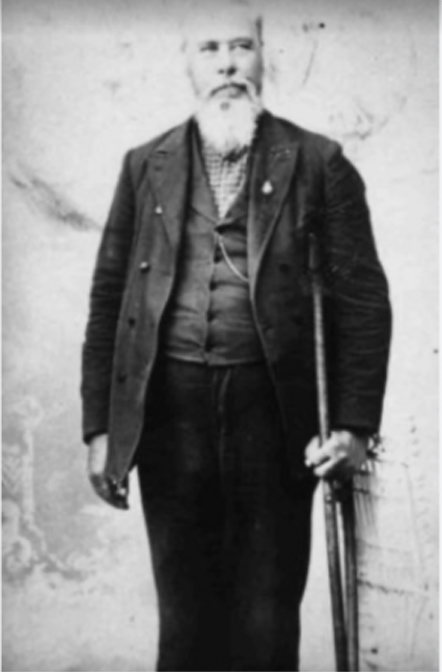
The two men built a very crude cabin (no longer standing) and purchased a 150 acre farm that they called the “Bar DX.” Eventually, according to Park Service stories, the two men grew a herd of a thousand head of cattle. Wolfe had sought a dry climate and he surely found it. It’s inconceivable to imagine that many cows on that kind of land. But they persevered.
Eight years after John and Fred left home, John’s daughter Flora Stanley finally made the long journey to see her father. She was accompanied by her husband Ed and their two children, Esther and Ferol. Flora was appalled at the conditions her father and brother were enduring in this brutal landscape and demanded that John built something more suitable for the enlarged family. Wolfe complied and with the help of Fred and Ed, they constructed a larger cabin, with a wooden floor. Anyone who has been to Wolfe Ranch would have to ask himself, if THIS is the improvement, what did the original cabin look like? It must have sent Flora into shock.
According to the website Intermountain Histories, “The men hauled timber from the Colorado River to use for the walls. They built the roof out of a frame of small logs and a large center beam. Fred and Ed laid bark from juniper trees and dirt from the surrounding hills over the top of the frame. The children helped stuff clay into the cracks between logs for insulation.” The cabin sat adjacent to Salt Wash, and no doubt Wolfe and Family followed the deep gorge to its intersection with the Colorado. It was almost a 20 mile round trip from the cabin and just the quicksand would have presented a challenge. But finally the new cabin was ready to be occupied.
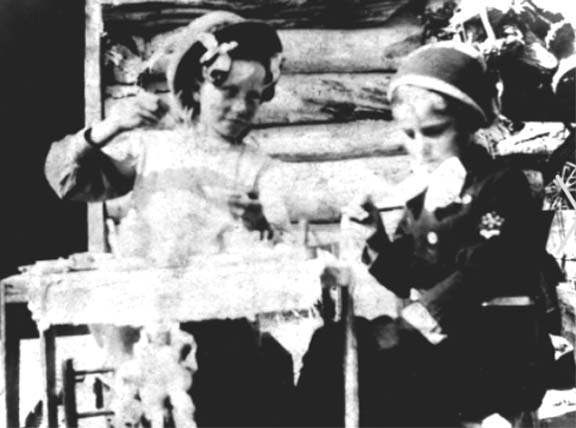
Flora and her family endured the “new” cabin for two years, but in 1908 she insisted on moving to Moab so that her children could attend school. Two years later, in 1910, John and Fred gave up the cabin as well and joined the Stanleys. Wolfe sold the ranch to a Moab local, Tommy Larsen, and Wolfe and his kin moved back to Ohio. John Wesley Wolfe only lived three more years and died in October 1913.
ENTER MARV TURBOW, IN THE MOST TRAGIC OF WAYS
In 1913, J. Marvin Turnbow bought the ranch from Larsen. He had come to Utah a few years earlier from Texas, looking for opportunities to raise a herd. A year later he filed homestead papers on the ranch. But just a year later the Turnbow Family became the subject of one of the most horrific and tragic crimes that the little town of Moab had ever endured.
From the scant records that can be put together, Marv Turnbow arrived in the Moab area around 1905. He met and married Jennie Walker and together they had three children, Addie, Raymond, and Hettie. But the marriage was turbulent from the beginning. According to the April 21, 1916 edition of the Grand Valley Times, Turnbow believed that “improper relations had existed” between Jennie and a man named Clyde Bailey. According to witnesses, the secret romance between Jennie and Clyde had begun some five years earlier. Turnbow would later claim that he had earlier befriended Bailey who “had been the recipient of Turnbow’s hospitality,” but that Bailey had “abused that friendship by making love to his wife.”
Bailey left the area, but the Turnbow marriage continued to fall apart. Finally in the spring of 1915, Marvin and Jennie agreed to separate, and Jennie moved to Salt Lake City where, according to the Times, “…she was known to be with Bailey.” But divorce in that day and age was almost unthinkable and family members attempted to “affect a reconciliation.” Jennie agreed to return. According to the Times, “..she arrived at Moab and the man and wife resolved to start life anew. They moved to Green River to be away from gossiping tongues and from which place Turnbow could look after his cattle.”
But Clyde Bailey followed the Turnbows to Green River and according to witnesses, Clyde was seen at the Turnbow’s home almost every night that Marvin was away. According to the Times, Marv’s little boy accidentally spilled the beans when he asked his father if he had been home the night before, “…as a man had been in the house.”
On December 24, 1915, both Bailey and Turnbow boarded the train at Green River. Theysat face to face on the short ride, neither of them saying a word. But clearly some kind of showdown was coming. At Thompson, the train stopped. Bailey exited first. Turnbow was right behind him. Witnesses for the prosecution claimed it was cold blooded murder. Defense witnesses and Turnbow insisted that Bailey was reaching for his own weapon when Turnbow opened fire. Bailey died almost instantly. Officials searched Clyde’s body for weapons and did indeed find a small pistol, but it had slipped through a hole in his coat pocket and into the lining of the jacket. Turnbow insisted that he could see Bailey reaching for his weapon when Marv opened fire. But clearly Turnbow had come to kill Bailey. Later, evidence showed that Turnbow had inquired about train arrivals from Salt Lake City and whether it would stop at Thompson. Turnbow was making plans to confront Bailey.
Jennie Turnbow took her children to Moab where she shared the home of “the old Roberson house, now owned by F.B. Hammond.” (GVTimes) . At about 6 AM on Tuesday, March 7, 2926, two men living in another part of the house, Ed Singley and Delbert Farnsworth, heard gunshots come from an adjoining room. Fearful of entering the room but expecting the worst, they ran to get the sheriff, W,J Bliss and the doctor, Bruce Easley.
What they found when they entered the bedroom is best told by the Grand Valley Times,
“When the party entered the house, they were met with a sight they would not soon forget. The three little children were in their bed, covered with blood. And the woman was lying on the floor beside them, her dress completely saturated with blood. An examination of the children was immediately made to determine if any of them were still alive. One of them, Hettie, was still breathing…she regained consciousness and spoke about the shooting. But died about five o’clock.”
Jennie had emptied all eight rounds of her pistol into the three children. One of them had been shot four times by his mother. Then Jennie Turnbow reloaded her weapon and shot herself four times in the chest, falling to the floor beside the bed.
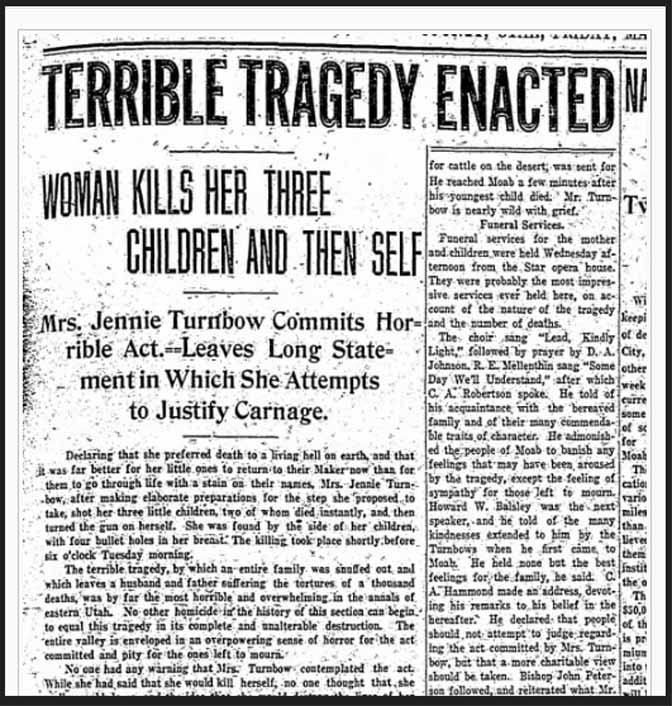
The Grand Valley Times observed:
“Declaring that she preferred death to a living hell on earth, and that it was far better for her little ones to return to their Maker than go through life with a stain on their names, Mrs Jennie Turbow, after making elaborate preparations for the steps she proposed to take, shot her three children, two of whom died instantly, then turned the gun on herself….the killing took place shortly before six o’clock Tuesday morning.
“The terrible tragedy by which an entire family was snuffed out and leaves a husband and a father suffering the tortures of a thousand deaths, was by far the most horrible and overwhelming in the annals of eastern Utah. No other homicide in the history of this section can begin to equal the tragedy in its complete and inalterable destruction. The entire valley is enveloped in an overpowering sense of horror for the act committed and pity for the ones left to mourn.”
Turnbow was tending to his cattle at Salt Wash when word reached him of the tragedy. The Times reported he was “wild with grief.” He arrived at the bloody scene just minutes after the last of his three children, still clinging to life, gave up. Marv Turnbow was allowed to attend the funeral of his three children and that of his wife. Jennie and Addie, Raymond and Hettie were buried together in a common grave.
Marv Turnbow was allowed to attend the funeral of his three children and that of his wife. Jennie and Addie, Raymond and Hettie were buried together in a common grave.
According to the Times, “Funeral services for the mother and three children were held from the Star Opera House. They were probably the most impressive services ever held here, on account of the nature of the tragedy and the number of deaths.” After a hymn by the choir and a prayer, D.A. Robertson addressed the gathering. “He spoke of his acquaintance with the bereaved family and of their many commendable traits of behavior. He admonished the people of Moab to banish any feelings that may have been aroused by the tragedy, except the feeling of sympathy for those left to mourn….Howard Balsley was the next to speak and told of the many kindnesses that had been extended to him by the Turnbows when he first arrived in Moab. He held none but the best feelings for them.”
And finally, “C.A. Mammond devoted his remarks to his brief in the hereafter and declared that people should not attempt to judge regarding the act of Jennie Turnbow, but that a more charitable view be taken.”
Marv Turnbow was allowed to attend the funeral of his three children and that of his wife. Jennie and Addie, Raymond and Hettie were buried together in a common grave.
THE TRIAL
Despite the community’s outpouring of grief for the horrific murders of three innocent young children, and even a measure of sympathy for their mother, the fact remained —Marvin Turnbow’s fatal shooting of his wife’s lover had been the final straw for Jennie Turnbow. On January 16, 1916, Turnbow was brought before the court to face charges in the shooting. The Times reported that, “Marvin Turnbow was held to answer to the district court on a charge of second degree murder of Clyde Bailey at Thompsons on December 24, 1915. He was released on a bail of $2000 to await the April term of the district court.
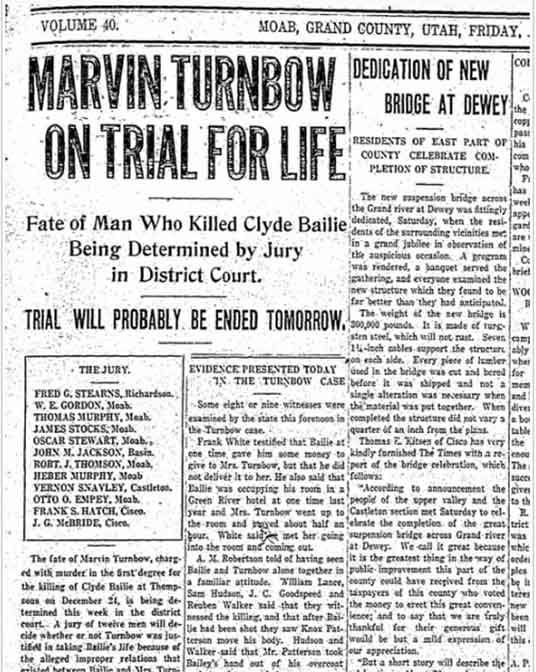
The defense offered no witnesses in Turnbow’s defense but did cross-examine some of the prosecution’s witnesses that included Ray Moore, Mark Beeson, Mervin Davis and Sheriff W.J. Bliss.
On April 16, 1916, the trial began. Twelve men represented the jury. The original charge against Turnbow, second degree murder, had been dropped by the court. Now, with more evidence of his alleged preparations to commit the crime, the charge had been upgraded to first degree murder.
Witnesses called before the court testified both for and against Turnbow. One witness to the shooting claimed that after Bailey’s death he had reached into Bailey’s pocket and recovered the gun. Another suggested that the gun had slipped through a hole in the coat pocket and had delayed Bailey’s ability to fire. There was no doubt that shots only came from Turnbow.
Roy Moore, a friend of both Bailey and Turnbow, who was aware at least of the rumors about Clyde and Jennie Turnbow had urged Clyde to stay away from Green River, where the Turnbows were then residing. But Bailey insisted on seeing Jennie. The witness claimed that he had read letters from Bailey to Mrs. Turnbow that contained “endearing language.” Bailey had traveled to Glenwood Springs but had decided to take a return train to Green River. As Bailey exited the train at Green River, the court heard Roy Moore “said he called Bailey a fool.” Bailey is reported to have replied, “Ain’t it the truth.”
Turnbow had made inquiries the day before, regarding train schedules and which trains would stop at Thompsons. Both men boarded the eastbound train at Green River and were within site of each other for the entire trip. When the train pulled into the Thompsons depot, the Times reported that, “Bailie had stepped off the train first and had walked no more than twelve feet, when Turnbow, who was following him, fired on him. He fired three shots into Bailey’s body.”
Attorney Samuel A. King represented Turbow in his defense. King stated that “Turnbow killing Bailey was a natural consequence of the improper relations which he charged had existed between Bailey and Mrs. Turnbow for five years before the homicide occurred. According to the Times, “Twelve witnesses were called by the defense…and all of them related circumstances tending to show the familiarity that existed between Bailey and Mrs. Turnbow.”
On April 28, the Grand valley Times reported the verdict:
“NOT GUILTY’ IS VERDICT BY THE TURNBOW JURY
Twelve Men Decide that Killing of Clyde Bailey was Justified Under Utah Law
The jury called it “justifiable homicide.” In 1916, the Utah law read that:
“Homicide is justifiable when committed by any person in either of the following cases…
4…when committed in the sudden heat of passion, caused by the deceased to attempt to commit rape, or to defile the wife, daughter, sister, mother or other female relative or dependent of the accused, or when the defilement has already been committed. Section 4169. C.L. 1907.
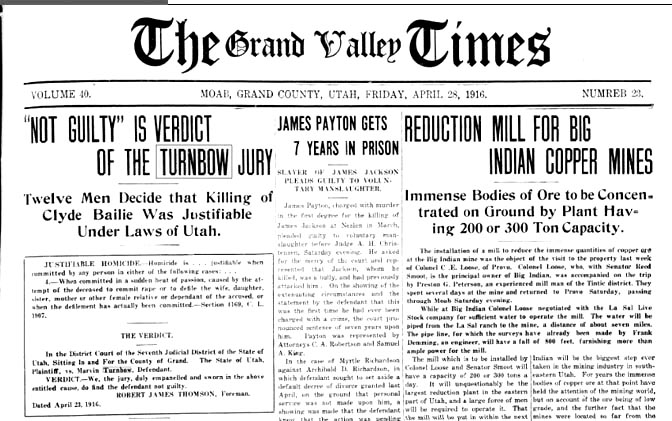
The Times noted that the jury deliberated for about 18 hours and that Turnbow was given his freedom at 12:30 PM the next day. Clearly, the murder of the three children cast a shadow over the proceedings and no doubt influenced the jurors. But in addition to the emotions that the tragedy had inflamed, the Times did note that, “…six men had testified that Bailey had previously threatened Turnbow, and was attempting to reach his gun when he was killed.” The Times added that, “this evidence was unassailed, uncontradicted, and unshaken.”
The murder trial of J. Marvin Turnbow was over. Life in Moab seemed to return to normal almost as quickly as the nightmare had begun.
TURNBOW’S NEW LIFE
Turnbow began to put his life back together. He continued to run his herd along Salt Wash and tended to his cattle. He had a place in town, but spent a lot of time at the cabin.. Just a few years after becoming a widower, Marv married another young woman from Moab, Susie Walker. She had children from a previous marriage and Marv was happy to be their step-dad. Of those step-children was Marilee “Toots” McDougald. (Toots was my next door neighbor in Moab for many years, and who was the star of the very first Zephyr Extra last year…To read the full story of Toots, click here.). Whatever difficulties existed between Marv and his first wife, his marriage to Susie by all accounts, was a happy one.
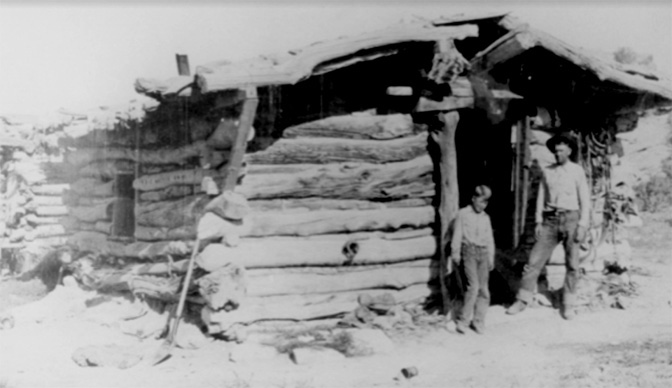
Toots shared many stories about her step-dad, especially their visits to the ranch and Turnbow Cabin. For several years, Toots spent her summers there.. By now, in the mid-1920s, Marv Turnbow had become one of the more prominent ranchers in the valley. According to The Times, he purchased another ranch at the far south end of the valley, the Dalton Ranch. But more than anything, Toots remembered those trips to the cabin. In a 1989 interview with me, we returned to the cabin and she talked about those times…
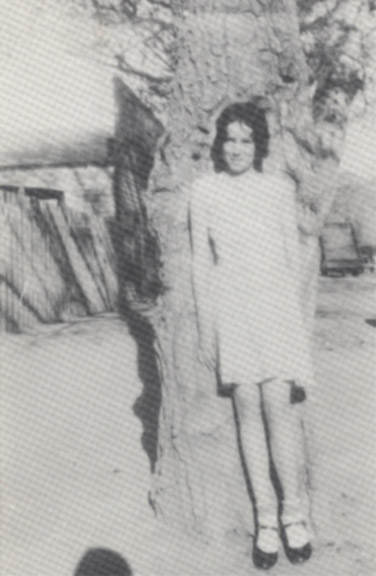
“We used to leave Moab in the morning on horses and ride up Courthouse Wash for five or six miles. There was a good horse trail that would lead up to Balanced Rock and down to Salt Valley and the cabin. Of course, you couldn’t ride a wagon on it….And we’d bring most of our food. We’d bring canned milk, and to this day I can drink canned milk right out of the can. And flour and salt and coffee, and things Mother canned. We couldn’t keep chickens out there or the coyotes would eat them.”
She remembered the old fruit trees near the cabin that were still there in the 20s, but which have long since withered and died. Also gone was the corn crib, built on stilts and placed in water-filled coffee cans to keep out or drown any rodents that tried to get in. But Toots marveled at how well the cabin itself had survived. The same massive center beam, “still, the biggest, straightest juniper log I’ve ever seen,” holds up the slightly sagging roof.
The family stayed two to three weeks at a time during the summer. Marv hauled water on horseback in big metal cans from a spring just upstream from the homestead and often Toots rode with Marv to round up new calves. The chore of branding hurt Toots almost as much as it did the calf. “He’d rope one of them and I’d take the rope and wrap it around my saddle horn. Dad would jump off his horse and throw the calf down and tie off its legs. In the meantime, we’d built a fire and got the iron red hot. Then he’d dehorn it and earmark it and brand it. And the little things would cry and run their tongues out half a city block. Meanwhile, I sat on my horse and cried. Every time Dad branded, I cried.”
Once, while driving cattle up Salt Wash, Toots and Marv came to a place where the horse would have to jump. “Dad didn’t want me on the horse when it jumped, so he scooped me off and sat me on a ledge. All of a sudden he grabbed me back. Well, there was a big rattlesnake right there between my feet…it had 14 rattles on it.”
In the evenings, Marv demonstrated the art of making flour sack biscuits. “He never used a pan. He’d roll up the sleeves of his long-handled underwear which he wore year-round. He’d scrub his hands and he’d get this sack and roll the top down and make a hole in the flour and smooth it out just like a bowl. Then he’d put in some baking powder, some salt and some shortening and mix it all around. Then he’d start adding water, a little drop at a time, and just keep working it with his hand. When he got enough he’d pinch it off and when he was through, you couldn’t find one lump left in that flour sack.”
Before going to bed at night, they’d always turn the horses loose; they never hobbled them. The horses were something that Marv Turnbow took great pride in and which Toots always remembered.
“He curried and combed his horses and trimmed their tails and manes. He took beautiful care of them…they never looked scroungy, ever.”
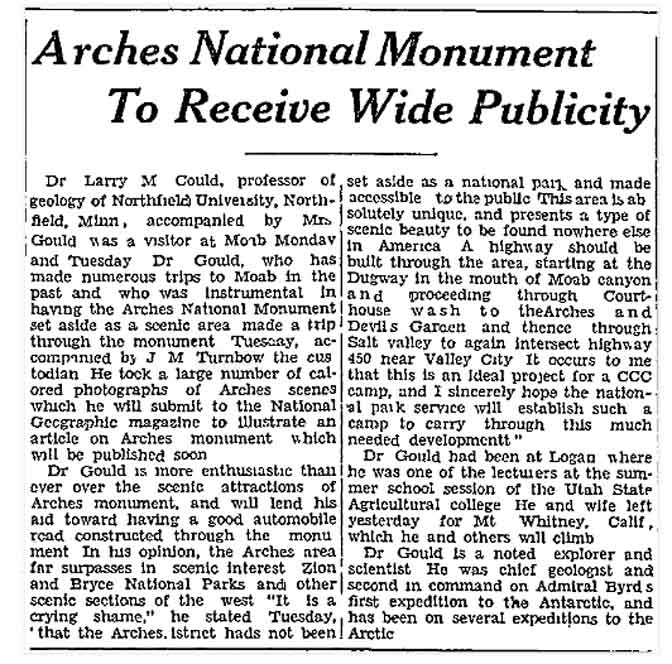
THE FIRST ARCHES CUSTODIAN
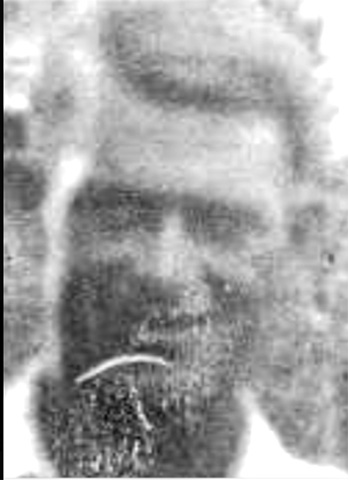
Turnbow knew the Arches country better than anyone. In 1924, a distinguished geologist from the University of Michigan, Lawrence Gould, was completing some surveys in the La Sal Mountains and had gone south to see the first national monument, Natural Bridges. But locals recommended he take the time to visit an area near Moab that most people called “The Windows.” Turnbow was the first and only person to be considered to lead Gould through the extraordinary area. Gould was overwhelmed and later he wrote:
“Whereas the bridges represent the grandest examples known illustrating a type of natural feature resulting from stream erosion, ‘The Windows’ show equally well the fantastic and bizarre effects produced only by the wind. I know of no place which is such a veritable museum showing the work of the wind as this little known locality. Here one may see most superb examples of caves, arches, chimneys, bridges and the like all carved from a massive red sandstone.”
Turnbow, who knew very little of the American landscape except Texas and the canyon country is still remembered, with a certain level of derision, as saying, “I didn’t think there was anything unusual about it.” And indeed, if anything, for a man trying to make a living as a rancher in some of the most difficult and forbidding countries on Earth, many early Westerners who had come to start a new life often saw Nature and its gifts as an impediment to their success.
But Gould came away with nothing but praise for the area. Within five years, thanks to Gould, and local supporters of this new industry called “tourism,” and even boosters from the railroad companies, the tiny monument was created in 1929.
*****
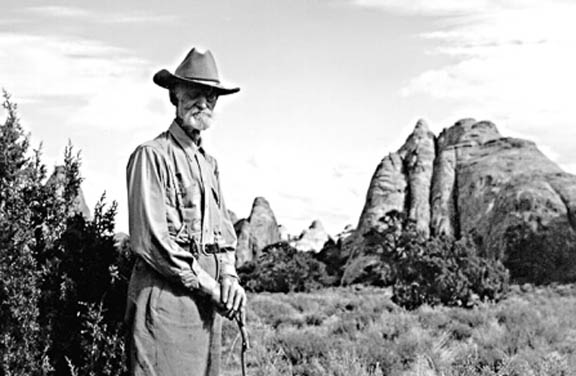
Now local politicians and Moab notables like Bish Taylor, the local newspaper editor, and Doc Williams, also an enthusiast, pushed to expand the Monument to protect areas left out of the original proclamation.

Turnbow’s name showed up frequently in the local press. He became active in various civic events, expanded his cattle operation and was even there to give away his step-daughter Toots McDougald when she married Dick Wright. The Times even thought it was news when Turnbow delivered a truck load of eggs to Salt Lake City!
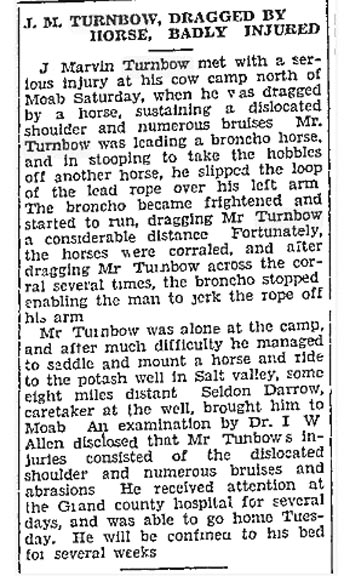
Moab citizens expressed concern when Turnbow was badly injured in an accident with a horse and his injuries were reported in the Moab newspaper. He was apparently alone at his cabin, inside his corral, and was trying to un-hobble one of his horses. Somehow a loop of rope snagged Marv and the horse it was attached to spooked and dragged him a considerable distance, back and forth inside the enclosure. Marv was in great pain but managed to climb on his horse and ride eight miles to a potash well in Salt Valley. The caretaker could see he was in serious distress and transported Marv to Moab and medical attention. Dr I.W. Allen determined that he had dislocated his shoulder and was bruised and bloody from head to toe. But as was the tradition in those days, Turnbow shook off his injuries, healed quickly and as noted, and led yet another government sponsored “Arches Scientific Expedition,” less than a year later.
The Roosevelt Administration, and especially its Interior Secretary, Harold Ickes, was eager to utilize the president’s power to create or expand national monuments across the West. In 1938, with the stroke of a pen, FDR increased the size of the monument from a mere 2200 acres to more than 33,000. At the time, it was hard to find many locals who opposed the move and the proclamation was praised by town leaders and the Moab Times. Many wondered however, why anyone in their right mind would travel hundreds or thousands of miles to see these strange rocks and spires and canyons.
There was a push to improve the roads in the area and to perhaps start promoting its scenic features in a more aggressive way. The National Park Service also needed someone to manage and oversee the monument; it was the unanimous advice of Moabites that only one man knew the country well enough to become the first “custodian” of Arches National Monument. It was J. Marv Turnbow of course.
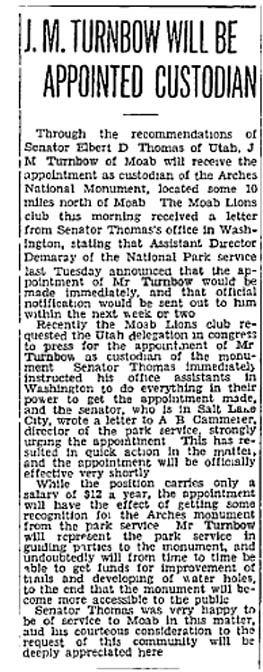
Marv kept an eye out on the new Monument, but in those days, you could count real tourists on one hand. Mostly Marv continued working his ranch, which had now become an inholding and was surrounded by the park lands. In 1937, Marv announced he was stepping down as custodian; he weas replaced by Harry Reed. Reed and his brother and parents had come to Moab yeast earlier; harry was known for his photographic skills and he began putting that talent to good use. Almost all the early black and white photographs of the monument from the late 1930s and early 1940s are the work of Harry Reed.
But Marv continued to ranch. He and Susie had more kids; both Susie and Marv were especially happy for Toots and Dick Wright. Never had they seen a happier couple. Life was good.
Then on February 12, 1940, a friend of Marv’s, Don Loveridge, invited him and Ed Kerby to take a spin in his brand new car. Both Marv and Ed knew that Don took a lot of risks when driving and liked to go fast. Marv and Ed reluctantly climbed in, Loveridge gunned the engine, and they took off in a cloud of dust. They were reaching speeds of 80 to 100 mph, when Loveridge lost control and crashed the car just beyond the original Mill Creek bridge. Kerby survived his injuries, and Marv was still conscious. but his lower body had been crushed. By the time the family and the sheriff could reach the scene, Marvin Turnbow was dead.
The families of Marv and Ed Kerby filed a lawsuit against Loverridge, citing his reckless behavior and asked for $20,000 in compensation. (So far I’ve not been able to find information that reveals the outcome of that litigation). Later Susie sold the ranch to Emmit Elizondo, who eventually sold the land to the Park Service.
RE-THINKING ‘TURNBOW CABIN’
From 1914, when Marv Turnbow bought the ranch, and for thirty years after Turnbow’s untimely death at 55, Moabites and visitors to the area alike, called the old log cabin “Turnbow Cabin.” It was true that Wolfe and his son and son-in-law built the cabin and the credit will always belong to John Wesley Wolfe and his family. But was it fair to completely erase the memory and history of Marv Turnbow and the 26 years he owned it?
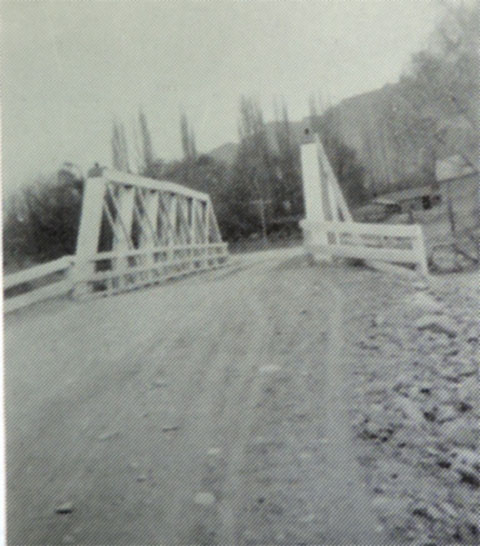
Wolfe arrived in southeast Utah in 1898, a decade later than park historians had assumed.He was already 69 years old and as noted, his Civil war injuries had permanently disabled him. It’s doubtful that either John or his son Fred did much exploring, other than the misery of chasing stray cattle out of box canyons on a hot July day. Once Wolfe’s daughter and family arrived in 1906, Wolfe and his son were living in near squalor. The cabin was only occupied by the Wolfes for a couple years before his daughter Flora insisted on moving to Moab with her husband and children. Soon after, John Wolfe and son followed them. By 1910, John Wesley Wolfe and his family were back in Ohio. So though they founded the homestead, their history was brief, and it’s doubtful that Wolfe had any real connections to Moab. One NPS document noted that whatever foodstuffs John and Fred couldn’t grow at the cabin, they ordered via a Sears Roebuck catalog. But they always traveled to Thompsons to order and pick up supplies. It was an easier ride.
Meanwhile, Marv Turnbow, the man who really occupied and made a life out of that land, who used the cabin regularly, who led two scientific expeditions into the Arches country because no other man on earth knew the country like Marv, and who finally became the very first custodian—this man’s history has mostly been lost. He certainly deserves more than a footnote.
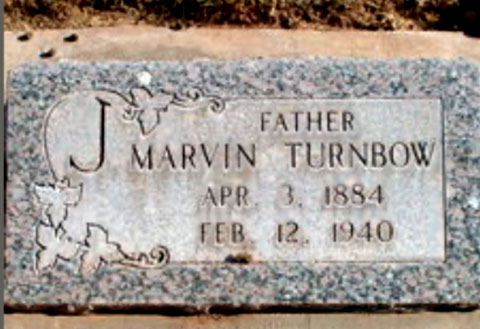
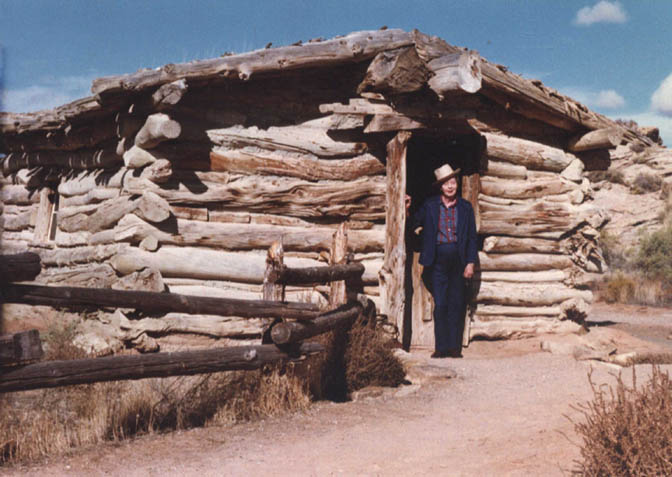
click here.
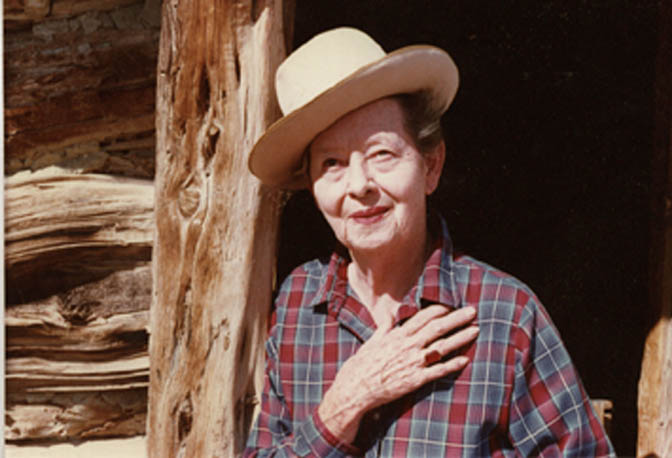
(NOTE: I’m not advocating removing Wolfe’s name or changing it back to “Turnbow Cabin.” But it would be to the park’s benefit to add some valuable information for park visitors who want to know the entire story of this unique part of Arches National Park…JS)
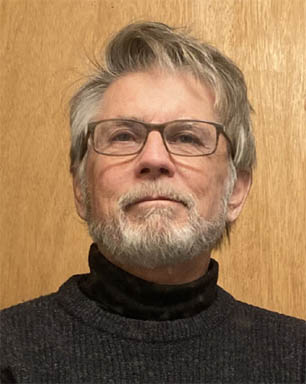
Jim Stiles is still the founding publisher & editor of The Canyon Country Zephyr. And is still Clinging Hopelessly to the Past Since 1989.” He can be reached at: cczephyr@gmail.com
TO COMMENT ON THIS STORY, PLEASE SCROLL TO THE BOTTOM OF THIS PAGE.


And I encourage you to “like” & “share” individual posts.
Why they can’t just leave the site alone is beyond me,
but that’s what Facebook likes to do.
ALSO NOTE: I post old photographs and stories from our 25 year old archives every day. Pictures from Herb Ringer, Edna Fridley, Charles Kreischer.. even a few old photos from my Dad. So if you want to stay caught up on our historic photo collections,
be sure to “follow” us on Facebook…Thanks…Jim
https://www.facebook.com/FansoftheCanyonCountryZephyr/
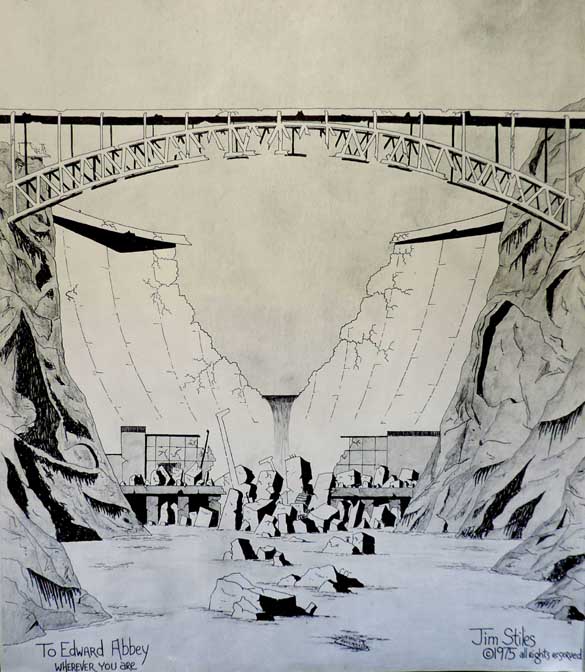

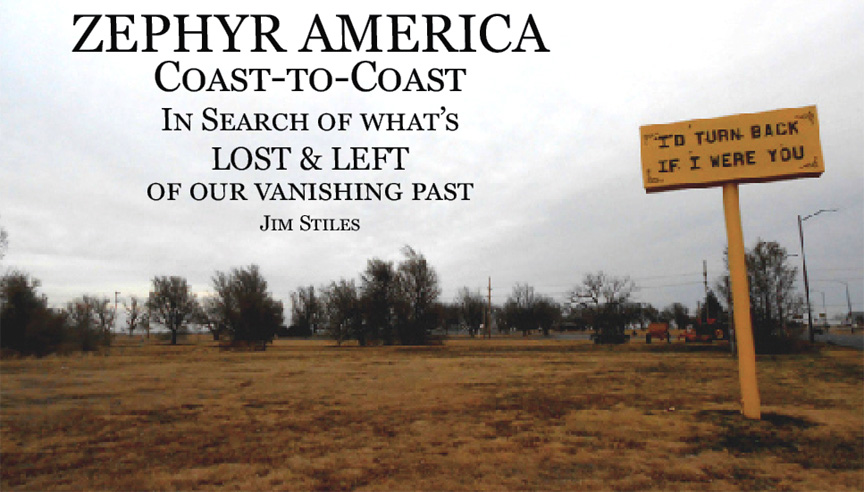
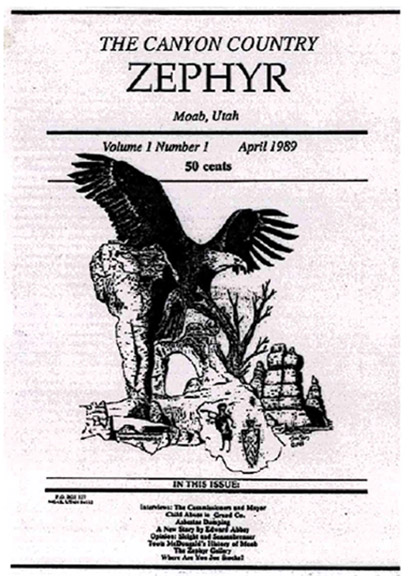
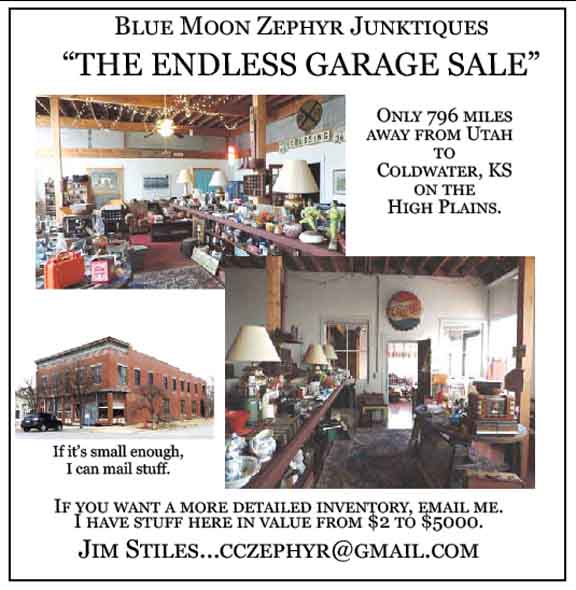
https://www.facebook.com/profile.php?id=100086441524150
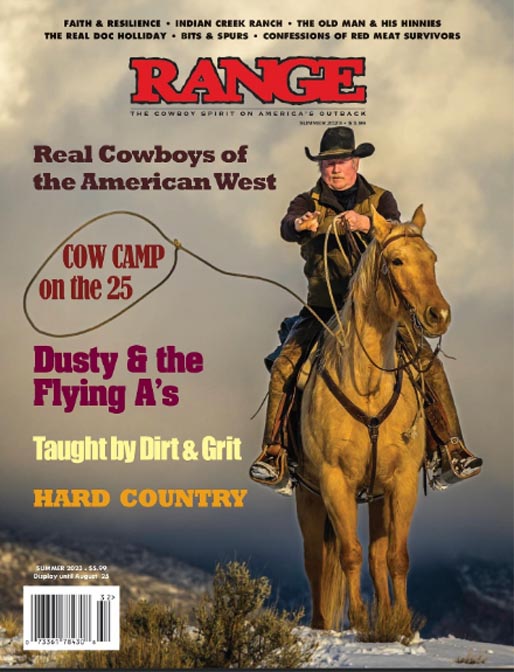
NOTE: The summer issue of RANGE includes a tribute to lifelong Moabite Karl Tangren.

And check out this post about Mazza & our friend Ali Sabbah,
and the greatest of culinary honors:
https://www.saltlakemagazine.com/mazza-salt-lake-city/
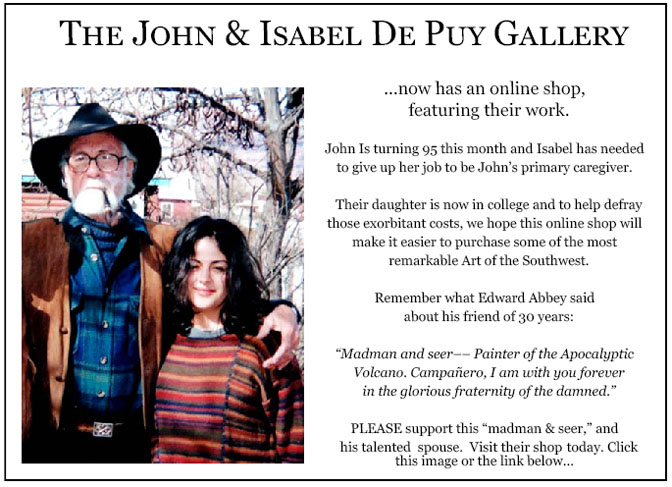
Adios Amigo…
More than six years ago, The Zephyr, me & four other individuals were sued for defamation by the former Moab City Manager. Faced with mounting legal bills, my dear friends John and Isabel De Puy donated one of John’s paintings to be auctioned.
ALL the proceeds went to our defense.
Thanks to them, our bills were almost completely covered.
Now I’d like to return the favor. Check out the link below and their online shop… JS
https://www.depuygallery.com/shop.html

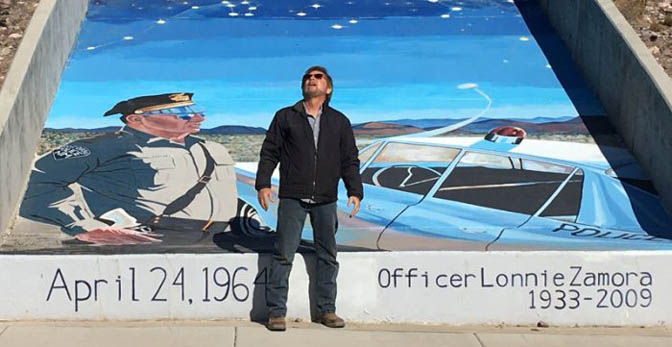
https://www.canyoncountryzephyr.com/2023/06/25/searching-for-klatu-my-ufo-vacation-jim-stiles-zx68/
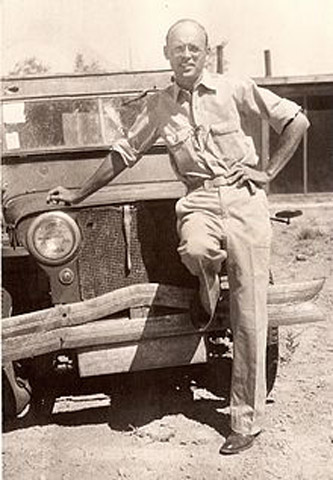
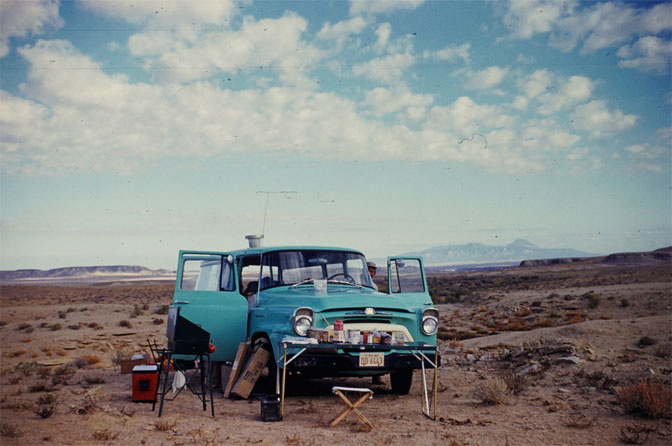
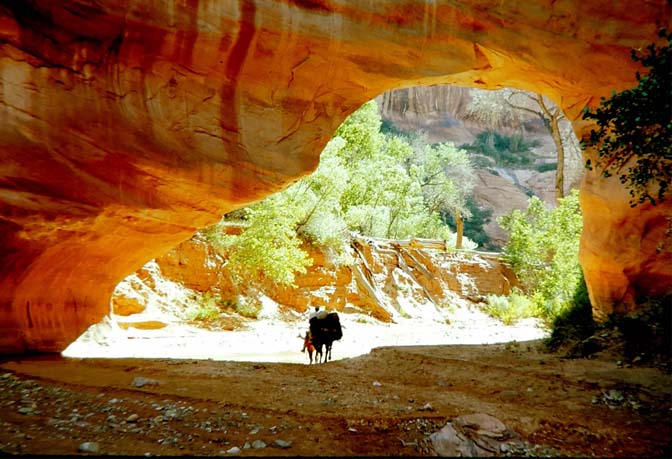
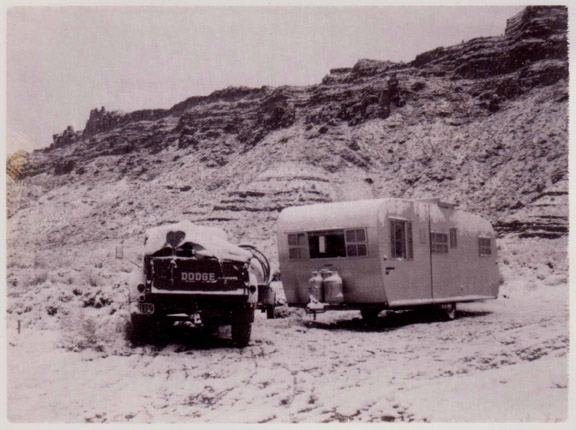
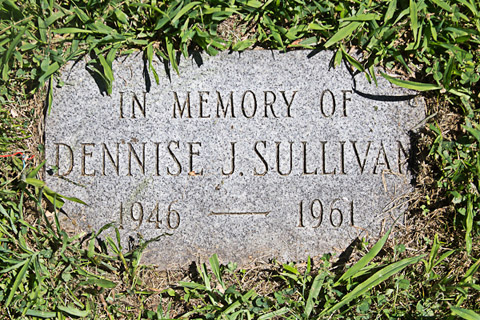
by Jim Stiles (ZX#8) https://www.canyoncountryzephyr.com/2022/05/15/60-years-later-still-searching-for-dennise-sullivan-by-jim-stiles-zx8/
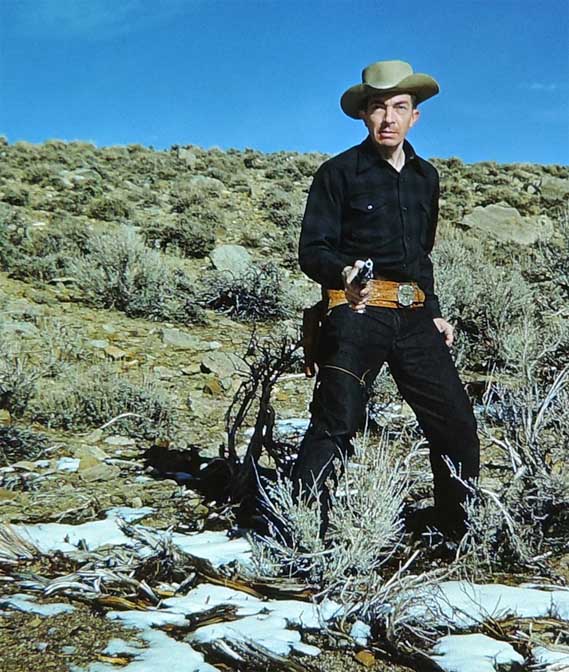
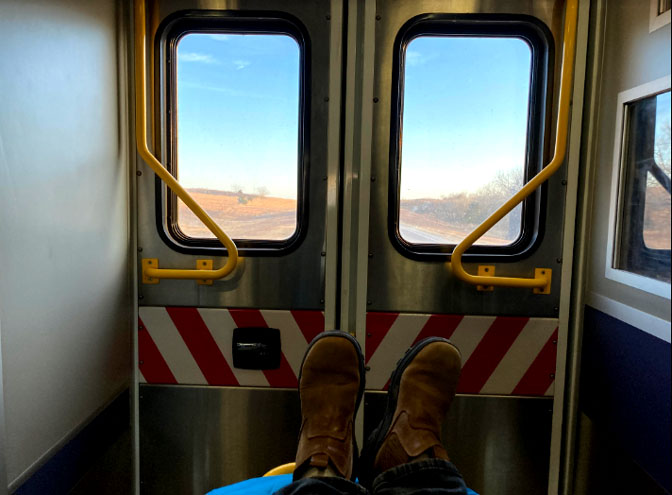



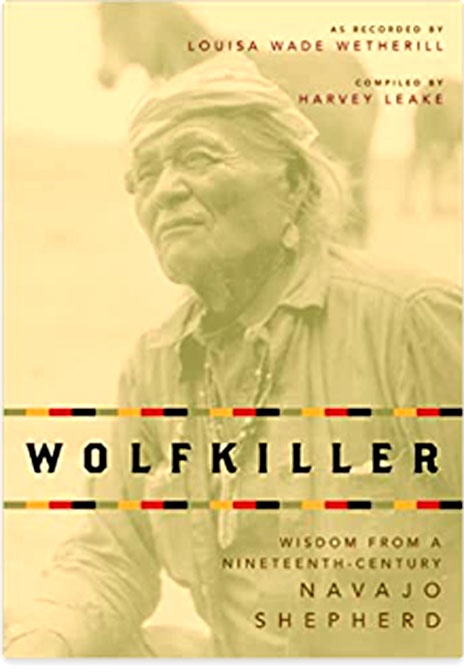


What a story! I can only think Mrs. Turnbow must’ve had a terrible guilt complex and felt she’d brought shame upon her children, what with the Dad shooting the interloper (and I’m glad the Dad was found innocent—unlike the young Marine who deterred a guy who was threatening subway riders and is now being charged in Manhattan for murder! He didn’t tackle the guy because he was black but only to keep him from hurting anyone–and I’m sure hedidn’t mean to kill him–altho I feel the guy deserved it!) But I just don’t know how anyone could kill one’s own children. She must’ve just become insane momentarily. But this type of history needs to be told and you’re doing a bangup job!
I wish you could write your own autobiography. What a life you’ve had. Thanks for the comment.
This is a remarkable chronicle of a shocking tale. This tragic and surprising story had passed from general memory by the time I moved to Moab in the 1960s, and was probably familiar only to relatives and friends of Marv, Jennie and Clyde.
Unlike many of the other communities in southeastern Utah, Moab carried a jaded reputation and in many ways this story is a window into the wild West.
Great research, great writing. This post is thoughtful and weirdly entertaining.
A well written window into the past. It reads like a screen play. A sad story yet Toots makes it a happy ending.
Toots was a force of Nature.
Well written story, Jim. My first reaction was I thought these sad tragedies only take pace in our era.
Paragraph #5: Powell was a Civil War . . .” — a slip for Wolfe?
J Marvin Turnbow was my Grandfather, his son Bruce Marvin Turnbow with his second wife Suzie,was my father. I will be visiting the “Turnbow” Cabin next month with my youngest sister in honor of what would be Dad’s 100th Birthday on October 16th 2023. It’s been many years since I last visited the cabin and the Arches National Park. We are proud to be Turnbow’s and look forward to singing happy birthday to Daddy! I hope my Grandfather’s legacy will live on as the first Custodian of the National Arches Park And like my Auntie “Toot’s” said… I will always call the Wolfe cabin, as it was better known as the “Turnbow Cabin”. Maybe someone from the “Zephyre” could meet us there for nostalgia’s sake . We are the true grandchildren of J Marvin Turnbow’s ! Hope to see you there! Sincerely Wanda Turnbow